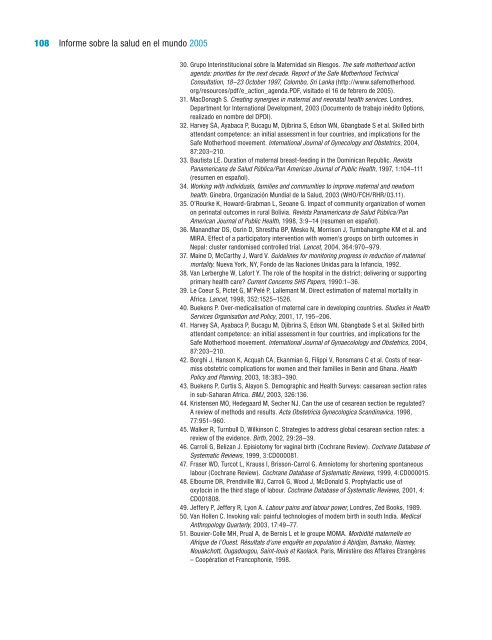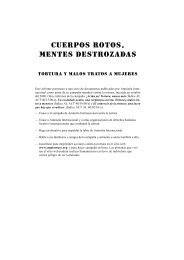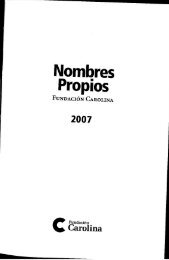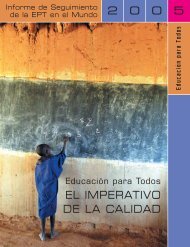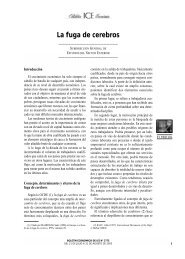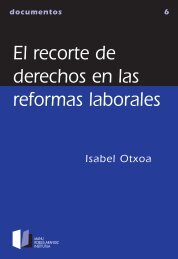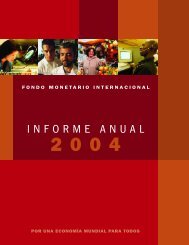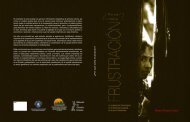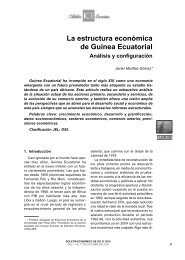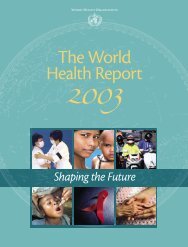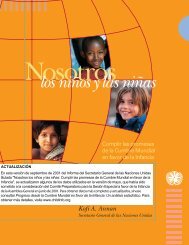Informe sobre la salud en el mundo 2005 ¡Cada madre y ... - eFaber
Informe sobre la salud en el mundo 2005 ¡Cada madre y ... - eFaber
Informe sobre la salud en el mundo 2005 ¡Cada madre y ... - eFaber
You also want an ePaper? Increase the reach of your titles
YUMPU automatically turns print PDFs into web optimized ePapers that Google loves.
108 <strong>Informe</strong> <strong>sobre</strong> <strong>la</strong> <strong>salud</strong> <strong>en</strong> <strong>el</strong> <strong>mundo</strong> <strong>2005</strong>30. Grupo Interinstitucional <strong>sobre</strong> <strong>la</strong> Maternidad sin Riesgos. The safe motherhood actionag<strong>en</strong>da: priorities for the next decade. Report of the Safe Motherhood TechnicalConsultation, 18–23 October 1997, Colombo, Sri Lanka (http://www.safemotherhood.org/resources/pdf/e_action_ag<strong>en</strong>da.PDF, visitado <strong>el</strong> 16 de febrero de <strong>2005</strong>).31. MacDonagh S. Creating synergies in maternal and neonatal health services. Londres,Departm<strong>en</strong>t for International Dev<strong>el</strong>opm<strong>en</strong>t, 2003 (Docum<strong>en</strong>to de trabajo inédito Options,realizado <strong>en</strong> nombre d<strong>el</strong> DPDI).32. Harvey SA, Ayabaca P, Bucagu M, Djibrina S, Edson WN, Gbangbade S et al. Skilled birthatt<strong>en</strong>dant compet<strong>en</strong>ce: an initial assessm<strong>en</strong>t in four countries, and implications for theSafe Motherhood movem<strong>en</strong>t. International Journal of Gynecology and Obstetrics, 2004,87:203–210.33. Bautista LE. Duration of maternal breast-feeding in the Dominican Republic. RevistaPanamericana de Salud Pública/Pan American Journal of Public Health, 1997, 1:104–111(resum<strong>en</strong> <strong>en</strong> español).34. Working with individuals, families and communities to improve maternal and newbornhealth. Ginebra, Organización Mundial de <strong>la</strong> Salud, 2003 (WHO/FCH/RHR/03.11).35. O’Rourke K, Howard-Grabman L, Seoane G. Impact of community organization of wom<strong>en</strong>on perinatal outcomes in rural Bolivia. Revista Panamericana de Salud Pública/PanAmerican Journal of Public Health, 1998, 3:9–14 (resum<strong>en</strong> <strong>en</strong> español).36. Manandhar DS, Osrin D, Shrestha BP, Mesko N, Morrison J, Tumbahangphe KM et al. andMIRA. Effect of a participatory interv<strong>en</strong>tion with wom<strong>en</strong>’s groups on birth outcomes inNepal: cluster randomised controlled trial. Lancet, 2004, 364:970–979.37. Maine D, McCarthy J, Ward V. Guid<strong>el</strong>ines for monitoring progress in reduction of maternalmortality. Nueva York, NY, Fondo de <strong>la</strong>s Naciones Unidas para <strong>la</strong> Infancia, 1992.38. Van Lerberghe W, Lafort Y. The role of the hospital in the district; d<strong>el</strong>ivering or supportingprimary health care? Curr<strong>en</strong>t Concerns SHS Papers, 1990:1–36.39. Le Coeur S, Pictet G, M’P<strong>el</strong>é P, Lallemant M. Direct estimation of maternal mortality inAfrica. Lancet, 1998, 352:1525–1526.40. Buek<strong>en</strong>s P. Over-medicalisation of maternal care in dev<strong>el</strong>oping countries. Studies in HealthServices Organisation and Policy, 2001, 17, 195–206.41. Harvey SA, Ayabaca P, Bucagu M, Djibrina S, Edson WN, Gbangbade S et al. Skilled birthatt<strong>en</strong>dant compet<strong>en</strong>ce: an initial assessm<strong>en</strong>t in four countries, and implications for theSafe Motherhood movem<strong>en</strong>t. International Journal of Gynaecolology and Obstetrics, 2004,87:203–210.42. Borghi J, Hanson K, Acquah CA, Ekanmian G, Filippi V, Ronsmans C et al. Costs of nearmissobstetric complications for wom<strong>en</strong> and their families in B<strong>en</strong>in and Ghana. HealthPolicy and P<strong>la</strong>nning, 2003, 18:383–390.43. Buek<strong>en</strong>s P, Curtis S, A<strong>la</strong>yon S. Demographic and Health Surveys: caesarean section ratesin sub-Saharan Africa. BMJ, 2003, 326:136.44. Krist<strong>en</strong>s<strong>en</strong> MO, Hedegaard M, Secher NJ. Can the use of cesarean section be regu<strong>la</strong>ted?A review of methods and results. Acta Obstetricia Gynecologica Scandinavica, 1998,77:951–960.45. Walker R, Turnbull D, Wilkinson C. Strategies to address global cesarean section rates: areview of the evid<strong>en</strong>ce. Birth, 2002, 29:28–39.46. Carroli G, B<strong>el</strong>izan J. Episiotomy for vaginal birth (Cochrane Review). Cochrane Database ofSystematic Reviews, 1999, 3:CD000081.47. Fraser WD, Turcot L, Krauss I, Brisson-Carrol G. Amniotomy for short<strong>en</strong>ing spontaneous<strong>la</strong>bour (Cochrane Review). Cochrane Database of Systematic Reviews, 1999, 4:CD000015.48. Elbourne DR, Pr<strong>en</strong>diville WJ, Carroli G, Wood J, McDonald S. Prophy<strong>la</strong>ctic use ofoxytocin in the third stage of <strong>la</strong>bour. Cochrane Database of Systematic Reviews, 2001, 4:CD001808.49. Jeffery P, Jeffery R, Lyon A. Labour pains and <strong>la</strong>bour power, Londres, Zed Books, 1989.50. Van Holl<strong>en</strong> C. Invoking vali: painful technologies of modern birth in south India. MedicalAnthropology Quarterly, 2003, 17:49–77.51. Bouvier-Colle MH, Prual A, de Bernis L et le groupe MOMA. Morbidité matern<strong>el</strong>le <strong>en</strong>Afrique de l’Ouest. Résultats d’une <strong>en</strong>quête <strong>en</strong> popu<strong>la</strong>tion à Abidjan, Bamako, Niamey,Nouakchott, Ougadougou, Saint-louis et Kao<strong>la</strong>ck. Paris, Ministère des Affaires Etrangères– Coopération et Francophonie, 1998.


